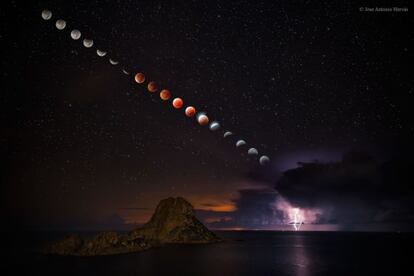How a Spaniard took a supermoon photo that caught the eye of NASA
José Antonio Hervás took his stunning composite image of Monday’s eclipse in Ibiza

At 1am on Monday September 28, José Antonio Hervás began taking a series of photographs of the sky over Ibiza. Over the next five hours, he used two cameras to capture the supermoon eclipse. The result is the image you see above, which was chosen by NASA on September 29 as its astronomy picture of the day.
“After a long night working until the early hours, I achieved what I had in mind and with the added luck of capturing some lightning on the horizon,” Hervás writes in the Facebook post below.
“As you can see, this is not one shot, but several, around 200 photographs, from which I have selected a single backdrop and fitted together the different phases of the lunar eclipse, following its trajectory.”
The image of the total eclipse and the supermoon, along with the electric storm, is in reality, composed of 19 photographs: “18 of the moon and one of the landscape,” says Hervás by telephone. That evening, the amateur photographer and time-lapse technology fan took more than 200 images.
After 40 minutes using Photoshop, he achieved the final result and posted it on the social networks. “It was very popular among friends, some of whom suggested I send it to NASA. It would never have occurred to me, and I never thought they would choose it, because there are plenty of photographers sending in their images. It’s like winning the lottery,” he says.
NASA checked the photograph to see how it had been created, and the next day, Tuesday, September 29, José Antonio woke up to an email informing him that his image had been chosen as the space agency’s astronomy photograph of the day. “It was good news. The photo has proved popular on the social networks, and since then the phone hasn’t stopped ringing,” he says. It has been shared more than 700 times from his Facebook page, and a further 3,000 times from NASA’s page.
Supermoon Total Lunar Eclipse and Lightning Storm: http://t.co/AfJ5kucw2g
— Astronomy Picture Of The Day (@apod) September 29, 2015
The 41-year-old says he knew exactly the image he wanted to create. “I don’t have a particularly good telephoto lens to capture the moon close up, so I decided to put it in the landscape. Es Vedra is a famous island off Ibiza, a magical place, full of energy. I knew that the moon was going to set there and it seemed the best place to take the photo,” he says. An unexpected storm at sea provided the perfect backdrop, making the photo unique.
Video: Hervás’s time-lapse photography of Ibiza.
Tu suscripción se está usando en otro dispositivo
¿Quieres añadir otro usuario a tu suscripción?
Si continúas leyendo en este dispositivo, no se podrá leer en el otro.
FlechaTu suscripción se está usando en otro dispositivo y solo puedes acceder a EL PAÍS desde un dispositivo a la vez.
Si quieres compartir tu cuenta, cambia tu suscripción a la modalidad Premium, así podrás añadir otro usuario. Cada uno accederá con su propia cuenta de email, lo que os permitirá personalizar vuestra experiencia en EL PAÍS.
¿Tienes una suscripción de empresa? Accede aquí para contratar más cuentas.
En el caso de no saber quién está usando tu cuenta, te recomendamos cambiar tu contraseña aquí.
Si decides continuar compartiendo tu cuenta, este mensaje se mostrará en tu dispositivo y en el de la otra persona que está usando tu cuenta de forma indefinida, afectando a tu experiencia de lectura. Puedes consultar aquí los términos y condiciones de la suscripción digital.
Archived In
Últimas noticias
The complicated life of Francesca Albanese: A rising figure in Italy but barred from every bank by Trump’s sanctions
How Japan is trying to avert ‘digital defeat’
Reinhard Genzel, Nobel laureate in physics: ‘One-minute videos will never give you the truth’
Pinochet’s victims grapple with José Antonio Kast’s rise in Chile
Most viewed
- Pablo Escobar’s hippos: A serious environmental problem, 40 years on
- Why we lost the habit of sleeping in two segments and how that changed our sense of time
- Trump’s obsession with putting his name on everything is unprecedented in the United States
- The Florida Keys tourist paradise is besieged by immigration agents: ‘We’ve never seen anything like this’
- Charles Dubouloz, mountaineering star, retires at 36 with a farewell tour inspired by Walter Bonatti









































